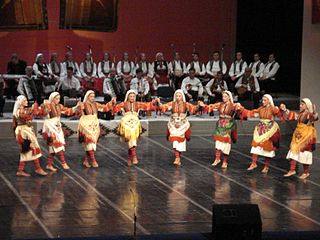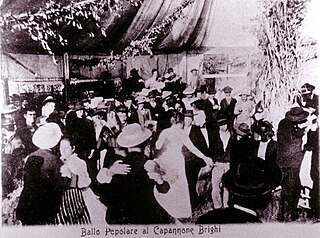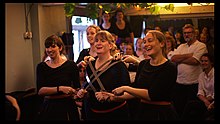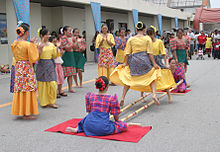The Mazurka is a Polish musical form based on stylised folk dances in triple meter, usually at a lively tempo, with character defined mostly by the prominent mazur's "strong accents unsystematically placed on the second or third beat". The Mazurka, alongside the polka dance, became popular at the ballrooms and salons of Europe in the 19th century, particularly through the notable works by Frédéric Chopin. The mazurka and mazurek are often confused in Western literature as the same musical form.

Dhol can refer to any one of a number of similar types of double-headed drum widely used, with regional variations, throughout the Indian subcontinent. Its range of distribution in Indian subcontinent primarily includes northern areas such as the Jammu, Himachal, Punjab, Haryana, Delhi, Kashmir, Sindh, Assam Valley, Uttarakhand, West Bengal, Odisha, Gujarat, Maharashtra, Konkan, Goa, Karnataka, Rajasthan, Bihar, Jharkhand and Uttar Pradesh. A related instrument is the dholak or dholki. Dhols are amongst other events used in Indian wedding ceremony processions such as Baraat or Varyatra.

The schottische is a partnered country dance that apparently originated in Bohemia. It was popular in Victorian era ballrooms as a part of the Bohemian folk-dance craze and left its traces in folk music of countries such as Argentina, Finland, France, Italy, Norway ("reinlender"), Portugal and Brazil, Spain, Sweden, Denmark, Mexico, and the United States, among other nations. The schottische is considered by The Oxford Companion to Music to be a kind of slower polka, with continental-European origin.

Hora, also known as horo and oro, is a type of circle dance originating in Aromanian and Romanian communities, especially in Romania and Moldova. It is also found in other South East European countries and culturally adopted by ethnic minorities such as the Ashkenazi Jews and the Roma.

Circle dance, or chain dance, is a style of social dance done in a circle, semicircle or a curved line to musical accompaniment, such as rhythm instruments and singing, and is a type of dance where anyone can join in without the need of partners. Unlike line dancing, circle dancers are in physical contact with each other; the connection is made by hand-to-hand, finger-to-finger or hands-on-shoulders, where they follow the leader around the dance floor. Ranging from gentle to energetic, the dance can be an uplifting group experience or part of a meditation.

The vast majority of the inhabitants of the United States are immigrants or descendants of immigrants. This article will focus on the music of these communities and discuss its roots in countries across Africa, Europe and Asia, excluding only Native American music, indigenous and immigrant Latinos, Puerto Rican music, Hawaiian music and African American music. The music of Irish- and Scottish-Americans will be a special focus, due to their extreme influence on Appalachian folk music and other genres. These sorts of music are often sustained and promoted by a variety of ethnic organizations.
This is an alphabetical index of articles related to dance.

Kolo is a South Slavic circle dance, found under this name in Bosnia and Herzegovina, Croatia, Slovenia, and Serbia. It is inscribed on the UNESCO List of Intagible Cultural Heritage for Serbia.

Austrian folk dancing is mostly associated with Schuhplattler, Ländler, polka and waltz. However, there are other dances such as Zwiefacher, Kontratänze and Sprachinseltänze.
The Philippines is home to several folk dances such as Tinikling, Pandanggo, Cariñosa, and Subli. Dance has integrated itself in Philippine society over the course of many years and is imbedded in Philippine culture.
Assyrian folk/pop music, also known as Assyrian folk-pop, is the musical style of the Assyrian people derived from traditional music that includes a broad range of stylistic varieties, which would also encompass fusions of Western genres such as pop, electronic, Latin, jazz and/or classical music, with a melodic basis of Assyrian folk.

Polish folk dances are a tradition rooted in ten centuries of Polish culture and history. Many of the dances stem from regional customs and historical events and are distinct from Czech, Slovak and Germanic styles. National dances include formal ballroom or ballet elements. Nowadays, the dances are only performed during major events, holidays or in tourist-oriented public spaces.
Croatian dance traditionally refers to a category of folk-dances, the most common being the kolo.

Liscio or ballo liscio is a genre of music originating in the 19th century in the northern Italian region of Romagna under the influence of Viennese ballroom dances including the mazurka, waltz, polka, schottische, march. It later became popular and spread to the rest of the country. The accordion, which was also a 19th-century invention, features prominently. The tradition contrasts with older Italian folk dances in which the fiddle was the primary instrument.

Bhangra is a type of traditional folk dance of Punjab area of the Indian subcontinent. It is done in the season of harvesting. According to Manuel (2001), bhangra is especially associated with the vernal Vaisakhi festival.
European dances refers to various dances originating in Europe. Since the Middle Ages, many European dances tend to be refined, as some are based on the court dances of aristocrats.

Belarusian folk dance is a Belarusian folk dance art, presented in the form of folk domestic or staged scenic dance. The history of Belarus and efforts to preserve Belarusian traditions have shaped the dances in use today, which have many ancient and archaic elements. These dances started to form in the 14th century, and originated in East Slavic rites. In the middle of the 19th century, traditional folk dancing began to merge with quadrilles and polkas from Western Europe.




























